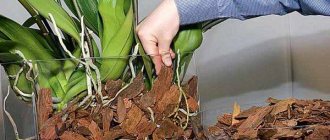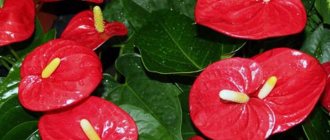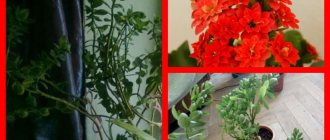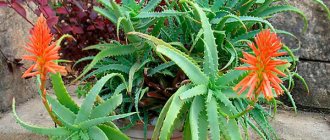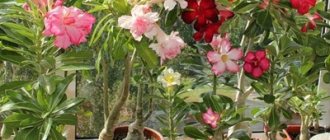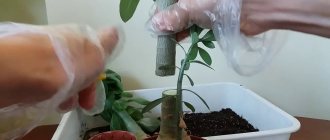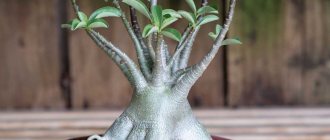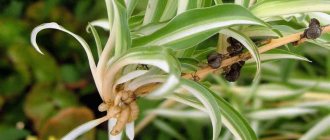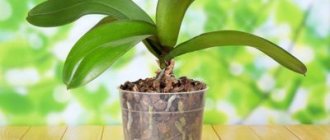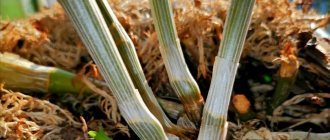Is it possible to achieve the appearance of buds at home and how to do it?
The most favorable environment for stone rose flowering is greenhouse or greenhouse conditions.
You can also get flowers to appear at home, but it requires much more effort. At home, adult adenium blooms only if all maintenance factors are met. To cause the formation and opening of buds, you need to strictly follow certain rules: The plant must be kept in a soil mixture with an acidity pH (6.5 - 7.8). It is this substrate that ensures the availability of nutrients. To grow adenium, it is best to choose a small pot. A stone rose will not bloom until it has entwined its roots around the entire earthen ball. Starting from the end of September, you need to keep the plant at a temperature less than +20°C, while simultaneously reducing the level of air humidity and light. Under these conditions, adenium sheds its leaves and enters a dormant period.
Watering needs to be reduced. In winter, it is important to provide the stone rose with optimal conditions for rest. The ideal temperature for winter is from +12 to +16°C
Indicators should not be less than +10°C, while it is important to maintain low air humidity. Watering should be done rarely and with a small amount of water. Moisten the earthen ball only if it is completely dry, while moistening only the surface of the soil along the edge of the pot with water. Excess moisture in the soil leads to rotting of the root system. Feeding should be stopped completely. With the onset of spring, when the growing point begins to swell, resume watering, gradually increasing the volume of water supplied. In the spring, when the leaves appear, it is necessary to provide the stone rose with long daylight hours. This is possible when kept on a south or east window. In addition, it is necessary to organize lighting. The artificial continuation of daylight hours should not exceed 12 hours. In early spring, start fertilizing once a month. Use liquid organo-mineral fertilizers with equal contents of potassium and phosphorus. Avoid exceeding the permissible solution concentration of two percent. Fertilizing with phosphorus and potassium helps strengthen adenium and speed up flowering. It is important to avoid excess nitrogen. Fertilizers for succulents or orchids, as well as complex fertilizers for flowering plants, are suitable. In summer, maintain a comfortable temperature for the stone rose from +25 to +27°C. It is recommended to place the plant on a balcony or loggia. Be sure to expose the adenium to the sun’s rays for four to five hours. During the rest of the daylight hours, provide a large amount of bright, diffused color.
Growing seedlings from seeds
Adenium can be grown from seeds at home. The seeds are soaked in warm water (25 degrees) for 48 hours.
Soak the seeds until they swell and fall to the bottom of the container of water. Soaking allows you to soften the seed shell and stimulate sprout germination. Usually the seeds germinate without soaking, but it’s worth increasing the chances. White “worms” should appear inside. Seeds capable of life germinate, we quickly transfer them to the ground.
To sow adenium, it is better to prepare a mixture consisting of:
- soil for cacti;
- perlite;
- gravel;
- coconut fibers.
The soil mixture can be “steamed” at 150°C to kill pathogens that may be in the soil and harm the seedlings. Sowing in a mixture of 2-3 mm grain size gravel with a small amount of soil and perlite is a very good idea: in such a substrate, adenium looks and grows completely differently than when sown in richer soil. After 4 months it will be smaller, but 4 times thicker, and some seedlings sprout and have 4 future branches, their height is only 3 cm.
The bottom of the pot can be covered with a piece of agrotextile so that the substrate does not spill through the holes at the bottom. This is not necessary, but helps keep the potty clean. Then we pour the substrate into the pot, press it down a little, trying to get a flat surface.
Sowing adenium seeds:
- The seeds are placed horizontally (in a lying position) on the soil without covering (adenium seeds are not buried in the ground, because fungi immediately attack them, in addition, the sprout will consume a lot of energy to germinate from the soil). You can lightly cover with a millimeter layer of sand so that the seeds do not dry out.
- The container or pot is covered to maintain optimal humidity. They use a transparent film pierced in several places; over time, more and more holes are made so that the seedlings get used to the humidity and temperature of the environment. We remove the film several times a day, water and ventilate the mini-greenhouse.
- We completely remove the film only when the first leaves appear (which happens within several days) - if you remove the film earlier, there is a risk that the seed coat will not come off completely, which leads to the need to remove it manually - which can damage the seedlings.
- By removing the film from the container, you can place the bottle without a bottom or stopper. We keep the substrate moist until the second pair of leaves appears - then we begin to gradually reduce watering (so that the substrate dries out before the next watering).
- Then the seedlings can be gradually accustomed to the sun by placing them in a south or west window, isolating them from direct sunlight, for example, with a sheet of white paper.
Adenium seedlings periodically give the impression that they are not growing at all - this is because the plant quietly develops a caudex, which grows downwards, increasing the size of the part from which the roots grow.
Do not overdo it with watering the seedlings, otherwise they may rot, photo below.
Small seedlings need to be transplanted into a pot after a month; it is advisable to cover the walls of the pot with bone meal fertilizer.
Month-old seedlings have different trunk colors. Some seedlings with a sharp green trunk (flower growers call this color “jade”) will have white flowers. Later, this feature of seedlings disappears.
Under favorable conditions, seedlings can bloom in 8-12 months.
Soil selection, planting and replanting
Before making adenium bloom at home, it is given comfortable growing conditions. First of all, it is the right choice of soil and regular replanting. The most ideal is considered to be light and at the same time moisture-permeable soil with an acidic or neutral pH. In principle, you can use store-bought soil that says “soil for orchids.”
In order for adenium to bloom, the soil should be selected more than carefully. If the soil is made independently, vermiculite (no more than 20 percent) and peat, as well as humus with coarse sand, are added to the soil. Ideally, peat is well replaced with coconut fiber.
Adeniums generally prefer looser soils, this could be:
- crushed brick;
- perlite with river sand;
- fine crumbs of plain charcoal.
In order to plant a plant, you can buy seeds, but it is easier to propagate adeniums in apartments using cuttings or layering. For planting or transplanting, it is better to choose a cloudy day and take a smaller pot. After the plant is transplanted, it should not be watered for several days. In general, adenium exhibits abundant flowering if it is replanted more often, but just do not overfeed.
The transplant is done as follows: the plant is carefully removed from the old pot, then the condition of the roots and stem is checked. All damaged shoots are removed, drainage is poured into a new pot, and then a layer of pre-prepared soil is poured. The young plant is covered with soil, carefully filling all the voids between the roots. Young flowers are replanted annually, and adults - once every three years.
In nature, the desert rose usually receives little moisture at this time; for this reason, it also needs to be provided with similar conditions at home so that it can rest normally. Only in this case will adenium bloom magnificently with the arrival of spring.
During winter holidays you need to do the following:
- the pot is placed in a slightly shaded corner;
- Regular watering should be reduced (water once a month);
- the plant should be kept at a temperature of about +16° C.
Do not be alarmed if adeniums shed all their leaves at the beginning of winter. In the spring, this perennial will “come to life”, then you can prune it, this will form a crown and help the process of bud formation. The process of pruning and beginning to form the crown should be done before flowering begins.
Unlike some other plants, adeniums are never pruned too low. Such pruning will lead to the formation of thin stems, which will not make it possible to form the ideal shape of the crown. Periodic pinching is also carried out (cutting off only the tops of the central branches and side shoots). Pinching, as well as spring pruning, creates conditions for stimulating branching and the formation of a proper crown.
In spring, the plant begins to be watered more often; the water may be slightly acidified. Periodically, adeniums are lightly sprayed with a regular spray bottle.
When to repot a desert rose
Like any indoor plant, adenium requires replanting.
Conditions for transplantation
Young adenium plants are replanted once every 2-3 years, seedlings - once every six months to a year, adults - when the roots break the pot.
Replanting is necessary if, due to overwatering, hypothermia or unsuitable soil mixture, the plant's roots begin to turn black or rot.
Another reason for replanting is a pot that is too large, in which the roots do not fill the entire soil.
Soil composition
When preparing the soil, it is imperative to take into account the origin of adenium. The soil should be loose, moisture- and breathable; by acidity - from slightly acidic to neutral. If you don’t want to bother with preparing the soil, take regular soil for succulents, add perlite and vermiculite. Adeniums also grow in a mixture of peat and coconut fiber with the addition of inert leavening agents (perlite and vermiculite). You can add leaf soil from under birch or linden trees (no more than 20%), sand, very fine expanded clay.
Preparing the plant for transplantation
It is advisable to replant in the warm season, preferably in the spring. A few days before the planned transplant, water the plant so that the roots are saturated with moisture.
Which flower pot to choose
It is very important to choose the right pot. Place adult plants in low and wide pots of light colors, since dark pots get very hot in the sun and the roots become uncomfortable at elevated temperatures. The dishes for adenium must have a lot of drainage holes. For young seedlings, use deeper pots. Choose a plastic or clay pot, but without glaze.
Transplantation process
To ensure a successful transplant, try to strictly follow the following procedure:
- Remove the plant from the pot.
- Rinse the roots.
- If necessary (for formation), cut off the roots of young seedlings.
- Treat the wounds with charcoal.
- Dry it a little (the drying period depends on the size of the wound and can last from several hours to 1-2 days).
- Place drainage and some soil at the bottom of the pot.
- Plant the adenium so that the roots are slightly exposed.
- Add soil, leaving the upper part of the roots exposed - this is how the “bonsai” shape is formed.
- Do not water or spray the plant for about a week.
Video: rules for transplanting adult adenium Obesum into new soil
Errors in care leading to lack of flowering
The reasons leading to the lack of flowering of adenium include errors in care - non-compliance with the rest period, as well as a mandatory component of maintaining a succulent - pruning the crown.
Excess nitrogen fertilizers
Errors in care primarily include overfeeding with fertilizers containing a high percentage of nitrogen. The plant “fattens”, increases the lush above-ground part to the detriment of the formation of buds. The gardener should remember this property of adenium and give preference to those fertilizers for succulents that contain a minimum of nitrogen.
Improper care during the winter dormancy period
Failure to observe a dormant period can also be a reason for failure to bloom. For adenium, it occurs with a reduction in daylight hours, and caring for the flower at this time requires a reduction in watering, no fertilizer, and a decrease in the room temperature to 15 degrees, preferably not higher than this figure, but not less than 12 degrees. If the grower does not comply with these conditions, he may not wait for the plant to bloom in spring.
However, some adenium growers believe that the flower requires stimulation of flowering, which consists of maintaining a low temperature and no watering. Often the plant takes a long time to recover from such stress, sheds its leaves or looks weakened for a long time with drooping leaves and. You can make adenium bloom at home by correctly following all the rules for caring for a flower that is at rest.
Pruning is not a mistake, but too drastic is the reason
Pruning, as an obligatory element of adenium care, can also be the reason why the plant does not bloom at the right time, if it is done radically, “under the stump”. Adenium growers remember that consistent flowering of the plant can be achieved only on young prunings of the current season. If there are few of them, accordingly, few flowers are formed, therefore, in early spring, to stimulate the formation of more buds, the succulent is cut off or the tops are pinched.
However, if there is a need, as a result of which most of the crown is removed, flowering will have to be sacrificed. A similar situation arises when pruning the root system during the formation of the caudex. Until the plant recovers from all the manipulations and grows new roots and a young crown, it either blooms sparingly or does not form buds at all in the immediate future after pruning.
Types and varieties of adenium with photos and names
All representatives of the culture, including cultivars, are easy to care for and beautiful. But it’s better to start getting acquainted with the plant by purchasing Adenium Obesum.
Adeniums: natural species
There are only 5 of them, although sometimes online articles give a long list. Care for all is almost the same. Most names are just synonyms and not different taxa. They will be given in the description of each species according to information from The Plant List database.
Obesum (Obese)
Adenium Obesum is the most common in culture, easy to care for. It is this adenium that is called the “desert rose”. In nature it grows up to 5 m, the thickening of the base of the trunk can reach a diameter of 1 m, gradually narrowing as it moves upward.
In a culture without pruning, with good care it usually grows to 1-1.5 m.
The bark is gray. Leaves:
- oval;
- dark green;
- glossy;
- rare;
- with a slightly pointed tip;
- the central vein is highlighted.
The species plant has flowers:
- pale pink;
- with a bright crimson edging along the edge;
- throat and tube white;
- wide petals 5;
- diameter 4-6 cm.
Synonyms of adenium obese:
- arabicum;
- arboretum;
- A. coetaneum;
- honghel;
- micranthum;
- socotranum;
- somalense;
- speciosum;
- tricholepis.
Multiflorum (Multifloral)
Adenium Multiflorum is an easy to care for shrub. Compared to other species, it grows relatively quickly. In nature it reaches 3 m.
The shoots are brownish, branch well, and tend to take a vertical position. Caudexes are cylindrical. The leaves are olive or dark green.
The flowers of the species plant can be confused with Adenium obese, but they:
- white with a red, pink or crimson border, the same strokes inside the throat;
- petals are narrower, with sharp tips;
- corolla diameter 5-7 cm.
Boehmianum
Adenium Boehmianum, despite its easy care and attractive appearance, is rare in cultivation. In nature, this adenium grows up to 3 m. The branches are long, thick, the leaves are grayish, up to 15 cm.
The flowers are pink, with a burgundy throat. The petals are wide and overlap each other, making the corolla look like a solid circle.
Oliefolium
Adenium Oleifolium is a low adenium, a shrub with thick geniculate stems that branches well. Leaves:
- lanceolate;
- olive;
- pubescent;
- folded inward like a boat.
Flowers:
- pink;
- look like stars;
- with yellow or white throat;
- the petals are narrow, with sharp tips.
This low-maintenance adenium deserves greater distribution in culture.
Synonyms:
- lugardiae;
- somalense var. angustifolium.
Swazicum
Adenium Swazicum is a shrub no taller than a meter. The leaves are narrow, light, pubescent, often slightly curled.
The flowers range from pink to crimson, with a dark throat and rhombic petals. The caudex looks like a bottle.
Adenium varieties
The flowers of adenium species are beautiful, but, in comparison with cultivars, they are significantly inferior. The varieties are propagated vegetatively, by cuttings that do not form a caudex, or by grafting. For the most part, these are interspecific hybrids that are easy to care for.
There are a lot of varieties. Among them are:
- simple;
- terry;
- plain;
- multicolor;
- with border;
- decorated with fancy designs.
The article is intended only to introduce amateurs to the variety of adenium cultivars. More detailed information should be found in professional catalogs.
Best of Siam
Best of Siam is a white terry variety with a fancy pattern, easy to care for. In the center of the petals there is a pink-crimson stripe widening towards the edge, the sides are decorated with rare splashes of the same color.
Leaves are variegated. On a green-olive background, whitish veins and lightened uneven areas stand out.
Double Color
Double Color changes color as the buds open. At first they are almost black, then, starting from the center, they gradually turn into dark red.
Caring for adenium is easy.
Dockson
Doxon is one of the first terry cultivars. Red-crimson flower, turning pink towards the center.
Before full bloom, the outer petals are wide open, the inner ones are curled into a bud.
Double Santa Claus
Double Santa Claus is an unusually spectacular adenium.
Terry, corrugated, soft pink petals curve beautifully, decorated with wide scarlet feathers in the center. Corolla diameter – 7-8 cm.
Hip-hop
Hip Hop is a simple red flower with a black border around the edge of the petals.
As you age, the dark streak becomes almost invisible.
Siam Vilet
Siam Violet is a simple lilac variety with gramophone-like corollas with a diameter of 4-6 cm. The color, saturated along the edges, gradually blurs towards the center. In the striped throat it changes to white.
Adenium Siam Vilet is easy to care for, the bush is literally strewn with flowers.
Sunny
Sunny bright pink terry corollas, plain, 5-7 cm in diameter.
The leaves are light green to salad green, very narrow, velvety.
Siam Red Plum
Small Red Plum forms a bushy bush with small, dark green leaves. Against their background, simple bell-shaped red corollas with a white throat look especially advantageous.
The flowers are small, 1.5-3 cm, but with proper care they almost completely cover the adenium.
Type Bright of Yellow
Tiple Bright of Yellow is one of the most original varieties. When blooming, the buds are pink-yellow, then the golden color gradually fades and disappears.
The petals are curved, wavy, covered with red feathers, lines and splashes.
Vanilla Ice (Vanilla Ice)
Vanilla Ice is an adenium with a simple corolla. Gramophones are white with lemon overlays, the petals are slightly curved.
Rules of care
Before making adenium bloom at home, it is given comfortable conditions. A lot of time and effort is not required to care for a desert guest. There are no such plants that require a lot of attention in deserts. Therefore, we make this plant bloom without making a huge effort.
Lighting
Since the perennial is light-loving, it should be placed in the brightest place. A window sill with a window facing south or southwest is most suitable for this. Unless young shoots from seeds cannot be placed on such a window.
During the rest period
The dormant period begins at the end of autumn. Adeniums must be “sent to rest.” Otherwise, they will not bloom, and if they do bloom, there will be few flowers, and the flowers themselves will appear small and pale.
To do this, place the container with the flower in a slightly shaded place. You also need to reduce watering to once a month. The room temperature should be no more than 15° C. Do not be alarmed if the plant sheds its leaves.
Regularity of pruning and pinching
At the beginning of the first spring month, when the perennial begins to “come to life” after hibernation, its shoots are cut off. This allows the crown to form and encourages the formation of buds.
You can also trim the roots. Particularly interesting shapes are obtained when planting a plant on a round plate. In this case, the root grows to the sides like an octopus. The roots can be strengthened with sticks or toothpicks, giving the roots an exotic look. In any case, the operation of pruning and crown formation must be performed before the plant begins to bloom.
Pinching means cutting off the tops of the central conductors and side shoots. The branches are cut off by 1-2 cm. This is the same pruning process, only the small tops are cut off. Pinching and pruning help stimulate branching and crown formation.
Watering
In winter, the plant is watered once a month. And with the beginning of its active growth, it is gradually watered more and more. For this purpose, water should be soft, slightly sour and warm. Watering should only be done when the soil dries out. Periodically, adeniums are sprayed with a spray bottle.
Soil selection
For this “exotic”, the soil must be selected very carefully. Light and moisture-permeable would be ideal. Fertilizers are added to the mixture. The reaction of the soil mixture should be neutral or acidic.
You can use store-bought soil that is designed for growing orchids. Perlite or vermiculite is added to it, but their percentage should not be more than 20%. The soil should also contain coconut fiber (peat can be used), humus with coarse sand. The ratios of the components are taken as follows: 5:2:1:2.
The plant loves loose soil, so adding a large amount of cultivators to the soil is even more beneficial. Their role can be played by:
- broken brick;
- sand with perlite;
- charcoal crumbs, etc.
Transfer
Adenium will bloom better and form buds earlier if it is replanted more often. But when replanting, you should not take a pot that is too large. Experts recommend doing this in the evening or on a stormy day. And after transplanting, you need to stop watering for several days. This desert guest responds well to transplants.
The transplant is performed as follows:
- the plant is carefully removed from the pot;
- look through the roots and stem to remove damaged ones;
- a drainage layer and a little soil mixture are poured at the bottom of the new flowerpot;
- Place the seedling and sprinkle it with the same soil, carefully filling the voids between the roots.
Reproduction methods at home
When breeding adeniums, you need to take into account that plants with a beautiful, full-fledged caudex are obtained only from seeds. But they do not inherit varietal characteristics with any care. But when they grow up, they can become a rootstock for branches of beautiful cultivars.
Adenium grafted onto oleander does not look like a tree.
Cuttings are much easier. But even in an adult plant, with good care, you can get a stem thickened at the base, only vaguely reminiscent of a bottle caudex. To give the adenium its original shape, it is necessary to expose the root during transplantation.
Layering is more difficult to do than taking cuttings. It is recommended to do this only on old plants in order to immediately obtain a large rooted shoot that does not require special care.
From seeds
Fresh seeds are sown at the end of February or the first half of March, preliminary, sequentially:
- soaking for 30 minutes in a solution of potassium permanganate;
- After staying in the stimulant diluted according to the instructions for several hours.
Then, step by step:
- A wide, shallow container is filled with a peat-sand mixture.
- Level the surface.
- Distribute the adenium seeds evenly.
- Sprinkle with a thin layer of substrate.
- Spray from a spray bottle.
- Cover with glass.
- Place in a bright place.
- Contain at 33-35° C.
- Maintenance – daily ventilation, removal of condensation, checking the humidity of the substrate.
When the shoots appear (in about a week), the temperature can be lowered, but not less than 18° C. Be sure to install additional bright lighting up to 12-15 hours a day.
Cotyledon leaves often come out with a shell. It must be carefully removed. If the vegetative organs are damaged (which is undesirable), but the growth point remains intact, it is likely that with proper care the adenium will continue to develop.
Seedlings dive after the appearance of 4 true leaves. Small pots or plastic cups must have bottom holes and drainage.
Cuttings
Root pieces of shoots 12-15 cm long in perlite or sand, after sprinkling the sections with crushed coal, and drying them in the shade for at least a day. Do not cover with glass or film. Care - more than moderate watering. Roots will appear in 4-5 weeks.
For adenium cuttings to take root, the temperature should not fall below 25° C.
By layering
At the end of spring or beginning of summer, select a shoot at least 2 cm thick. Next:
- A thin strip of bark is removed between the nodes.
- Blot the milky juice.
- Allow to dry for several hours.
- Treated with a stimulant.
- Wrap in wet sphagnum moss and cellophane on top. Secure the ends.
In about a month, roots will appear. The cuttings can be cut and planted in the usual soil for adenium along with sphagnum. Care is the same as for an adult plant.
Vaccination
The operation requires experience. It is better to train on “extra” specimens. The grafting is done on oleander or the grown caudex of an adenium seedling.
Step by step:
- Identical mirror oblique cuts are made on the scion and rootstock with a sharp knife or scalpel.
- Combine, firmly fasten.
- Care - frequent spraying, maintenance at 30-35°, bright lighting without direct rays.
Leaves or shoots that appear on the rootstock - oleander or adenium caudex - are immediately torn off.
Pinching, trimming and forming the adenium caudex video
If you want to get a unique branchy crown of a mini-tree, don’t be lazy about pinching and pruning it. Pruning is aimed at forming the crown and stimulating branching. Pinching has the same goals; it is carried out on seedlings obtained from seeds.
How to form roots in adenium
Keep in mind that the roots of adenium grow strongly, which is why the plant is gradually displaced above the surface of the earth. If the roots have risen more than 1-2 cm above the ground, they need to be trimmed urgently. To do this, the plant is freed from the pot, the lateral roots are cut off, and transplanted into a deeper pot.
How to form a caudex
Many people are attracted to the desert rose not by the flowering, but by the beautiful, unusual caudex (the thick trunk of the plant). It is formed in two ways:
- Trimming the central root. The first transplant of adeniums occurs 2-3 months after germination. The next one is in six months. When replanting, you need to trim the central root. This will cause lateral roots to grow. They can be twisted, laid out in a circle, and over time they will thicken more and more. The roots can be raised above the ground, which will give the caudex an unusual shape and good thickness.
- Formation of the Trinity caudex (Troika) . It is necessary to take three seedlings at the age of 3 months. They should be approximately the same in volume and height. We plant them close to each other and wrap them with cling film or tape. After a couple of months, remove the bandage and use a sterile knife to make shallow cuts at the points of contact. The deeper the cuts, the greater the chances of success. Again we tightly wrap the adeshki to each other and leave them for 2-4 weeks, after which they should grow together.
Problems with leaves: description, cause, treatment
Flower diseases can manifest themselves as follows.
The ends are drying out
With a sharp change in air temperature and drafts, the tips of the leaves may begin to dry out. Leaves also begin to dry out in strong bright sunlight or lack of watering. To prevent such a disease, it is recommended to move the flower to a more suitable place and monitor the soil moisture.
Turn yellow
Yellowing of the leaves may be due to a problem in the root system, for example, a pest or rot has appeared on the roots. This reaction also appears after replanting the plant, with abundant watering, excess fertilizer, or simply the leaves of the flower have become old. In this case, do not worry, you need to remove the yellowed leaves and continue to monitor the flower.
Fall off
There are situations when adenium sheds its leaves and does not bloom. This phenomenon can be encountered in the autumn; this is a normal situation for a flower. If a flower begins to shed its leaves before dormancy begins, there may be several reasons:
- The flower was planted in inappropriate soil. The problem can be eliminated with a transplant.
- Incorrect trimming. When pruning, you need to take into account the size of the caudex. The procedure is permitted only if the caudex is wide enough (read here what to do if the caudex of adenium shrivels, withers and becomes soft).
- Lack of moisture. Regular watering will help eliminate this problem.
- Leaves may also fall due to sudden temperature changes.
The variegation disappears
If a flower begins to grow only green leaves, there may be several reasons:
- The flower does not have enough sunlight.
- The flower became weak.
- Excess feed.
- Degeneration (Return from mutation to the original form).
In the first three cases, proper care must be provided.
During the mutation process, nothing can be changed; the flower will begin to grow white leaves. This phenomenon is very dangerous for adenium and can lead to death.
Round spots
Round spots indicate high air humidity and a poorly ventilated area. First, the leaves of the flower are affected, and then the root system begins to suffer.
To avoid this, you need to monitor the microclimate in the place where you grow adenium (read about growing adenium from seeds here). As a preventive measure, it is recommended to spray or water the plant with a fungicide. The drug should be used once a month so as not to cause addictive microorganisms.
Burn
If brown spots appear on the adenium, this indicates sunburn. Despite the fact that the desert is considered the birthplace of the flower, it should be gradually accustomed to the bright rays of the sun. The burn will disappear after renewing the leaves.
There is also a bacterial burn; it appears from increased soil and air humidity. Outwardly, it resembles solar, but methods of control include collecting and processing the affected leaves. It is recommended to treat the soil with special bactericidal agents.
Why are there no buds?
Adenium can not bloom for several years. In this case, the exact age of the stone rose should be determined. Perhaps adenium is still too young. If the specimen is old enough, it is necessary to find out the reason for the lack of flowering.
It is likely that not all containment conditions have been met. The most common source of the problem is the following care errors :
- Lack of lighting.
- Increased acidity of the soil, due to which the roots of the plant begin to die.
- Nutrient deficiency. This problem can be recognized by the condition of the leaves. If adenium is healthy, its leaves are smooth, glossy, and bright green. In case of insufficient nutrition, they turn yellow, lose their shine, become porous, and then fall off.
- Excess nitrogen fertilizers, which stimulate the growth of branches and roots.
- Frequent drying out of the earthen clod in the flowerpot.
- Excessive watering in the cold season, leading to rotting of the root system.
- Improper maintenance during the dormant period, as a result of which the stone rose was not able to accumulate enough strength and nutrients for flowering.
- Sometimes the buds fall off the day after they appear. This is a signal that the soil in the pot is too dry or the plant requires foliar feeding.
You will learn about other problems of adenium in this article.
What to do and how to make them appear?
If an adult plant refuses to form buds or fades too quickly, you need to clarify the rules for caring for adenium, find errors and make adjustments. In order for a stone rose to bloom, you must strictly observe the following conditions :
- Provide good natural lighting, as well as organize illumination using phytolamps.
- Adjust the temperature and humidity level in the room.
- Set up the watering regime.
- If the soil is too acidic, replace the substrate.
- Provide timely and correct fertilizing. If the flowering of a stone rose is delayed due to a lack of nutrients, and the soil contains complex fertilizers with a long period of action, it is necessary to carry out foliar feeding. Dilute the prepared mixture for foliar feeding of succulents, following the instructions. Spray the surface of the plant with the resulting solution.
- Provide adenium with proper rest every year in the winter.
What factors influence the flowering of adenium?
To stimulate the onset of flowering, it is necessary to provide adenium with comfortable conditions. The formation of inflorescences primarily depends on the following factors:
- Sufficient lighting. By its nature, adenium is a very light-loving plant, so it should be given the most illuminated place. Ideal if it is a southern or southeastern window sill. The only exceptions are young seedlings immediately after transplantation, as well as sick flowers.
- Presence of a period of rest. At the end of autumn, when daylight hours become short, adenium should be put to rest so that it can rest and gain strength. It is advisable to place the pot in a room with an air temperature of no more than 15 degrees Celsius and reduce watering to once a month. Adenium needs to be watered even when it sheds its leaves.
- Regular pruning. At the beginning of spring, as soon as the plant begins to emerge from the dormant period, elongated shoots should be trimmed. This will not only allow you to form a beautiful crown, but will also give an impetus to the planting of buds.
When growing adenium from seeds, we have the right to count on interesting caudexes, because this is precisely why seed propagation of this plant is good. However, that's not all. Each of us hopes that the seedling will bloom according to its variety. Our wish is not always fulfilled, but all the same, no matter what the flowering of a self-planted adenium seedling is, this is a small holiday and a big reward for the gardener for his efforts. So what is the first flowering?
First, you will have to come down to earth - the first flowering may not take place.
Your adeshka will be imbued with your desire and will give you the long-awaited buds in order to please his grower, but he may simply not have enough strength to bring what he started to a victorious end. Realizing that he did not calculate his strength, the seedling can dry out some or all of the buds. It’s a sad result, but you shouldn’t be discouraged either, because... this means that there will definitely be flowering soon. I often come across the question - when will adenium bloom from seeds?
The earliest flowering I heard of in our latitudes was 8 months.
On average, this is 2 years after sowing. It happens that even in the 3-4th year. The next question, naturally, is: what does this depend on?
The first and most obvious answer is from the growing conditions. I think there is no need to explain that if you put adenium in a dark, cool place, there will be no flowering. However, in such conditions, not only flowering... The more light your pet receives, while being warm and comfortable (by cozy I mean a suitable substrate and pot), the sooner flowering will occur. The second obvious answer is that it all depends on the type of adenium. The earliest flowering plant is Adenium obesum. There is an opinion that this is especially true for miniature adenium obesum. Adenium arabicum usually begins to bloom at a more mature age. And they grow it not for the flowers, but for the characteristic shape of the caudex. There is a less obvious, but important reason: the length of time before the first flowering depends on the immediate “parents” of the seedling. With adeniums, just like with people, the same father and mother are the same as the children. If pollination took place between two early flowering adeniums, then there is a very high chance that the seedling from the seeds resulting from this pollination will also bloom early. So, you saw the buds. What's your first wish? That's right - feed it, move it to a better place and something else. More precisely, it’s completely wrong - you don’t need to do all this. If adenium is about to bloom, it means it is happy where it is, and the main thing is not to change anything. Maybe increase the watering a little: this will be useful for the growth of buds. I understand that “doing nothing” in this case is quite equivalent to a feat, but you want to see flowering? Therefore, all that remains is to wait, and wait long enough. The “ripening” of the buds lasts about a month. The photo below shows the growth of a seedling bud that I planted on February 20, 2010. The first photo is dated March 2, 2011, i.e. one year and a few days after planting. Each subsequent photograph was taken one day later. Thus, you can see the dynamics of bud development almost from the moment of its inception to flowering. In addition to the growth of the bud, from the photographs you can see the growth rate of the branches that branched out at the place where the buds formed.
When does adenium bloom?
The second name of adenium is “Stone Rose”. The plant blooms with beautiful flowers that resemble gramophones. When adenium blooms is a question that interests many people. An adult plant begins to produce buds for the first time in spring - from the end of March. The second flowering occurs in autumn - early September.
Adenium amazes with its abundant flowering
Also, beginning flower growers often have a question about how long adenium grows before the first flowering. If the crop was propagated using cuttings, it will bloom much earlier than a plant grown from seeds. Adenium from seeds in most cases begins to produce buds for the first time in the 3rd or 4th year. However, in some species, flowers may begin to appear at the age of two years, although not in such numbers as in a more mature flower.
Attention! If the plant is already about 5 years old and has never bloomed, then there is some cause for concern.
Features of care after purchase
After purchasing a desert rose, caring for the plant will require some attention.
It is not recommended to replant the plant immediately after purchase; you need to give it time to acclimatize.
On average, 7 to 15 days are enough for this. The exception is cases when you become worried after discovering signs of illness.
If you purchase an Adenium flower in the fall, after a short time it may shed its leaves.
This is a natural process - preparation for winter; Adenium enters a period of rest. You should reduce watering and keep the room temperature cooler.
If you have little experience in growing succulents, it is better to immediately invite a specialist. An experienced florist will notice the signs of the disease in time, determine the treatment, and you will need to follow his recommendations.
Diseases and pests of Adenium, characteristic of them in tropical conditions, are rarely found in northern latitudes (read why the tips of Adenium leaves turn yellow and dry and what are the causes of diseases). The most serious danger remains rotting of the caudex, which occurs due to excessive watering at medium and low temperatures.
What happens after?
After flowering, the plant requires a long rest. You should reduce the amount of watering and stop fertilizing. This will prepare the rock rose for the dormant period, which lasts from October to February.
On our website you can find useful information on how to correctly form the caudex of adenium, as well as on pruning and shaping the plant.
Adenium can delight with lush flowering not only in the greenhouse, but also at home.
The main thing is to take proper care of the stone rose and not make mistakes in the process of growing it. In addition, you should not expect too young adenium to bloom.
Diseases and pests are a common reason for failure to bloom.
Most often, adenium is affected by rot and fungus, which are the result of improper watering. Both diseases begin, first of all, to damage the caudex, which stops not only flowering, but the development of the bush as a whole: the leaves turn yellow, the buds fall off without having time to form normally.
To get rid of this problem, it is necessary to treat the plant with fungicides, and cut off the affected areas and sprinkle with activated carbon.
Among the pests that prevent the tree from developing normally are spider mites, mealybugs and scale insects. Insects attack the soft and succulent parts of the bush, including the peduncle. Weakened adenium cannot grow normally and form inflorescences. Some pests are not noticeable on the surface of the bush, as they are small in size or hide on the back side of the leaf. Many of them are securely located in the axils of the leaves.
In the fight against pests it is necessary to use insecticides. Spider mites are destroyed with acaricides. During treatment, you need to thoroughly water the soil with the solution, since insect larvae are found in the soil among the roots.
Important! After treating the bush, you need to let it rest for about a month.
To make adenium bloom, you need to carry out the necessary care measures in a timely manner.
Graft
The florist has two grafting methods at his disposal:
- Flat.
- V-shaped.
It is possible that the first grafting option is more rational and less traumatic for the plant.
Because the:
- no need to split the rootstock on the parent bush;
- the grafted cutting itself has not two, but one cut (flat);
- the cut of the cutting fits tightly to the rootstock.
In addition, the place of flat grafting looks more aesthetic; with its help, cuttings from different bushes can be grafted onto one “stump”.
For the classic V-shaped grafting, the apical part is removed from the rootstock branch. The remaining stump is split, and a previously prepared cutting is inserted into the resulting gap, the lower edge of which is symmetrically cut off on both sides.
The grafting site is strengthened with adhesive tape, cloth, or plastic tape. The auxiliary material is removed after successful fusion of the graft material.
Prerequisites for successful vaccination by any method:
- the rootstock and scion must be healthy;
- there must be at least one living bud on the scion;
- the grafted bush and the plant that gave the cutting must be in the growth stage;
- trimming the edges must be done with a disinfected tool;
- the grafted plant must be kept in comfortable conditions;
- the connection point must remain stationary.
For a flat scion:
- The rootstock branch should be larger in diameter than the scion (or the same).
- The ends of the plant to be joined must have an even cut.
- After joining, the formed branch is carefully wrapped in polyethylene, and then the graft is securely secured using an adhesive plaster or electrical tape.
Adenium, like any plant, can encounter various problems, diseases and pests. To avoid this, read our articles on the rules of pruning and caudex formation.
When do they start to bloom after grafting?
Flowering of varietal adeniums and grafts occurs after a few months.
Adenium is a very “grateful” plant. For simple care and warmth, both spiritual and very real, he will definitely thank you with lush flowering. And it will allow experienced experimental flower growers to get buds of different colors on one branched bush.
Diseases and pests
Daylily is practically not attacked by pests. Improper care can provoke the appearance of diseases or parasites on exotic bushes.
Fungal infection of foliage
In terms of health, the main weak point of a plant is its roots. The fleshy thick roots of the daylily collect a lot of moisture inside themselves. Its excess quickly leads to rotting of the root mass. As a result, root rot or soft rot of the root collar may appear.
Fungal diseases usually affect the green part of the plant. The leaves begin to turn yellow from the tips, and over time the process covers the entire leaf plate. Sometimes yellow-brown spots or stripes appear on the foliage. The only way out is to remove all damaged foliage.
Additional Information. It is advisable to carry out prevention against fungal diseases every spring. Special preparations will help preserve the decorative appearance of the bush.
Parasites that can settle on a flower include:
- aphid;
- thrips;
- spider mite
The most effective method of combating them is preventive treatment.
It is important to do this regularly and according to instructions
Fleshy roots and stems attract slugs and snails to the bush, and sweet inflorescences are eaten by beetles and bronze beetles during the growing season. Gardeners fight these pests using folk methods, treating shrubs with infusion of garlic, mustard or hot pepper.
Errors during germination
Some gardeners, even after several attempts, still fail to obtain young succulent seedlings from seeds.
There are several basic mistakes made at different stages of cultivation that prevent you from getting a healthy young plant. The most common:
- Prolonged soaking of seeds. If you keep the seeds in water for more than 3 hours, they will “suffocate” and die.
- Planting seeds in peat tablets. Peat is highly acidic, which kills seeds even before they germinate. An excessively moist environment is created in peat soil, and the seeds simply rot in it.
- Failure to comply with temperature conditions. For the first 2 weeks, it is necessary to provide the seeds with a constant temperature of +28-32 °C. Fluctuations in numbers, their sharp decrease or increase - all this affects their germination and survival.
- Early transplant. Sometimes flower growers rush to plant newly emerged seedlings so that they have more space. For the first 1.5-2 months, plants are unable to survive changes in location, soil and microclimate. Until 4-5 leaves appear, they should not be touched at all.
Features of pruning “desert roses”
With regard to adenium, it is appropriate to apply all the rules for maintaining succulent crops.
Pruning has the corresponding specifics:
- All manipulations with crown formation are carried out against the background of reducing watering before and after pruning. This will reduce juice loss.
- It is necessary to choose a dry, sunny day so that the cuts dry faster.
- It is recommended to disinfect the cuts with crushed charcoal or a solution of brilliant green.
- All manipulations are carried out with a pre-treated sharp scalpel.
Neglecting pruning completely eliminates the decorative qualities of an exotic plant. When unkempt, adenium is a sparsely leafy plant with a bare trunk and one or two vertical shoots.
How is variegation transmitted during seed propagation?
Variegated adenium
What about variegated foliage? Variegation is a mutation that is best transmitted to offspring during vegetative propagation, i.e. cuttings (including grafted onto rootstocks). This does not mean that we will face complete failure and disappointment with the seeds.
The worst way to convey variegation is in the form of leaf edging or stripes, for example, varieties Superba and the like). But specks and spots are transferred well (varieties like Best in Siam).
We have a detailed article on the topic of variegated adeniums, read it if you are interested in variegated adeniums.
How to achieve adenium flowering at home
Adeniums are becoming increasingly common among indoor plants. These flowers have an unusual appearance, thereby attracting lovers of ornamental plants on windowsills in apartments and offices. And when the adenium bloomed, it was hard to take your eyes off it, it was so beautiful. But not everyone succeeds in getting them to bloom. To understand what the problem is, it is necessary to take into account the peculiarities of the care and propagation of amazing plants, because this determines whether they will bloom.
Adeniums belong to the Kutrov family. At first they grew only in the lands of Saudi Arabia. It was from there that travelers brought the “desert rose” to Europe.
This miniature tree has a fleshy, thickened trunk, mostly located underground. Branched shoots grow upward from the trunk. For this reason, the plant is often classified as a shrub. Under natural conditions, however, it sometimes reaches a height of 8 m. Moisture accumulates in the thickened part to provide the plant with it in dry times. For this feature, the plant is also called bottle plant.
The roots of the plant are thick, fleshy, and grow wider after planting in a pot. The roots look unusual and amaze with their decorativeness.
The leaves are small, elongated, rounded at the ends. Their surface is glossy or velvety. They are located on short cuttings alternately or in bunches.
Flowering plant. Its inflorescences amaze with their beauty and elegance, located on the tops of branches in the form of bunches. The flowers resemble simple funnels, are large and have many interesting shades. Sometimes there are species with double flowers. The flower “funnel” itself is colored unevenly, becoming lighter towards the center. There are a variety of shades: from bright to pale.
The adenium plant usually begins flowering in spring, summer or early autumn. Flowering lasts a long time, usually several months. Blooms in April - July or September - October, if it feels comfortable. But by creating artificial lighting, you can “make” this plant bloom in other months.
Briefly about the morphology of adenium
Indoor adenium attracts attention with its unusual structure.
Flowering gives the plant a special charm, which is highly valued by gardeners. The thick trunk and fleshy roots serve as moisture-accumulating organs and attract the attention of florist designers. The trunk has a clearly visible tendency to thicken at the basal part. While its upper part is narrower. A similar trunk structure is often observed in desert plants. It is called "bottle".
Adenium roots develop mainly the top layer of the substrate and also have the property of storing moisture. They often protrude to the surface, which increases the decorative qualities of the exotic. Root ventilation does not harm the plant at all. A similar structure of the root system is more common in adult specimens.
African exotic looks great as a bonsai. Florists often give its roots bizarre shapes.
The unusual structure of the succulent fades into the background when its flowers bloom. Any blooming desert dweller is captivated by the riot of colors of the fleeting African spring. Flowering of adenium is considered a natural phenomenon with proper agricultural practices. However, although growing an exotic plant does not present much trouble, the plant may not bloom for a long time. This circumstance greatly worries novice flower growers.
Anthurium does not bloom, but produces only leaves: reasons
There can be many reasons why anthurium does not bloom at home. Therefore, before you treat the bush and make it bloom again, you should find the real problem due to which the bush cannot produce buds.
Pot too big
Since anthurium has a weak root system, it is difficult for it to obtain nutrients from the soil. Therefore, the large container in which the bush is grown complicates this process even more. In this case, until the roots of the flower grow and fill the entire space of the container, it will not bloom.
Errors in watering mode
One of the main reasons why anthurium does not bloom at home is improper watering. This includes the irregularity of the procedure, as well as the use of low-quality irrigation water.
Note! Cold chlorinated tap water often causes root rot, causing the bush to stop blooming and the foliage to dry out.
Unsuitable temperature
The next reason why anthurium does not bloom for a long time is inappropriate room temperature
During the growing season, the temperature should be between 19 °C and 23 °C. It is very important not to allow sudden jumps in these indicators and not to lower them below 15 ° C, otherwise the plant will go into hibernation
Note! The bush is deliberately put into hibernation after flowering so that it can gain strength. In other cases, the room is maintained at the required temperature
Insufficient humidity
For tropical plants such as anthurium, humidity levels are very important. If they drop below 60%, then the plant slows down its life processes.
Deficiency or excess of essential microelements in the soil
During certain periods of anthurium development, the content and dosage of microelements in the fertilizer should change. Otherwise problems arise. An overabundance of nutrients can also affect the lack of flowering, as the plant may instead begin to grow only leaf mass.
Drafts
Due to increased humidity and high temperature, the room may become stuffy, so ventilation will be required. However, their frequency, especially during cool periods, can harm the plant. It is also worth avoiding strong drafts, which will tear off the inflorescences and leaves from the bush.
Mistakes made during transplantation
Anthurium does not bloom or grow due to improper transplantation. This procedure is considered complex and requires experience. Often, mechanical damage is caused to the root system and shoots, through which infections subsequently penetrate.
Important! When replanting, do not use contaminated garden tools.
Diseases and parasites
Due to improper care, pests and diseases often appear on the bush. Visually, such a plant begins to change color and fade. Inflorescences do not form, and the leaves curl and fall off.
The most common diseases affecting anthurium include:
- leaf rust;
- root rot;
- powdery mildew;
- septoria.
Pests that affect flowering include:
- mealybug;
- spider mite;
- aphid;
- scale insect
Improper care can prevent buds from opening and foliage from drying out.
Problems during cultivation
All troubles are associated with care errors. First of all, this is abundant watering of adenium, incorrect temperature conditions, and poor lighting.
No amount of care will cause the green leaves of variegated varieties to change color if the plant does not get enough sun.
Roots rot in the absence of drainage or lower holes, in dense soil. Adenium does not bloom due to the following care errors:
- planting in a pot that is too large - until the roots fill the container, there will be no buds;
- little sun;
- deficiency of potassium and phosphorus;
- excess nitrogen;
- sudden change in conditions of detention or care;
- temperature below 18 or above 38° C.
Adenium may shed its buds during the first flowering if the root is not sufficiently developed, even with good care. The plant had enough strength to move them forward, but not to open them.
The first leaves after wintering are often deformed. This is usually associated with a sudden change in care. But adenium must be checked for pests.
Description of the plant
The difference between adenium and usual indoor plants is that it looks like a rose and a tree at the same time. Its trunk serves as a storehouse of nutrients and moisture in case of drought, and drought is common in the desert. Only during the rainy season can adenium or desert rose replenish water reserves in its own tissues.
Another unusual phenomenon is that adenium blooms on New Year’s holidays, which can greatly surprise guests.
The adenium caudex is a thickening at the bottom of the trunk, essentially a root. Caudex, although located on the surface of the earth, does not participate in the process of photosynthesis. It is believed that the caudex should be located underground so as not to overheat and evaporate water, but succulent breeders expose it to the surface. After all, the thick trunk is the most remarkable thing about this flower.
The second advantage is the bright large flowers of adenium of regular or double shape, similar to rose blooms. Because of this, the plant received its second name - desert rose. The succulent has few leaves; they are elongated with a rounded tip, although they can vary depending on the varietal of the crop.
Many gardeners, having heard about the topical origin of adenium, refuse to grow and care for it at home, because all species are extremely demanding on the climate. But there is good news: selection does not stand still and new varieties have already been created that feel good in the middle zone.
They need watering and tolerate working radiators in the winter. Therefore, you can take on the cultivation of adenium with peace of mind. Even if you grow it from seeds, its growth will be noticeable day after day, and flowering can occur within a year.
Growing conditions in the wild
Wild relatives of adenium are not spoiled with care. Moreover, they grow under the scorching sun, with a minimum of nutrients and water. Most of the caudex is located underground, the roots are strongly intertwined, forming complex patterns.
Wild adenium has almost no leaves. This is due to the lack of nitrogen in sandy soil and the almost complete absence of organic matter. At home, you can achieve a beautiful combination of greenery and flowering thanks to regular fertilizing.
Interesting! Flower growers consider the benefits of fertilizer for adenium from the position of “how to make the caudex thick”
And even all care comes down to how to achieve thickening of the caudex.
Description of the process: when does it start to bloom, how long does the period last?
Depending on the variety of adenium, flowers differ in the number of buds in the inflorescence and the number of rows with petals. The color varies from soft cream to crimson, combinations of colors or changes in shade from the middle to the edge are possible. There is a pattern in the form of stripes, and there are also varieties with double flowers.
Despite the variety of adenium varieties, they all have common characteristics:
- flower ovaries appear at the ends of branches;
- the bud ripens within one to two months;
- the flower blooms in up to one week.
The ripening time of the bud and the duration of flower blooming are influenced by the number of petals and the number of their rows. The denser the bud, the more time and light it will need to ripen. And the smaller the number of petals, the more intense the bouquet bloom will be.
The average lifespan of one flower depends on the plant variety and is 10 days.
Pests
Mealybug
An insect that lives in leaf axils. It affects young shoots, foliage and buds. Signs of damage are:
- White, waxy, cotton-like coating.
- Sugary discharge in case of long-term illness.
Adenium stops growing and begins to experience problems with flowering. Severe defeat leads to death.
Fighting methods:
- If the disease is in its early stages, the plant can be treated with a soap solution, removing the scale insects and their secretions. In the future, it is necessary to carry out preventive treatments with a weak soap or alcohol solution.
- Spray the plants with special preparations in accordance with the instructions. Repeat the treatment weekly.
IMPORTANT! The older the larvae, the more difficult it will be to rehabilitate the plant.
Bedbugs
Sucking insects that appear on pods with adenium seeds and seriously damage them. Treatment with special preparations helps in this case. A mustard solution may also help. Dissolve 100 grams of dry powder in ten liters and spray the plant damaged by pests every three days.
Caterpillars
They may appear on adenium due to transfer from other plants. This often happens when keeping a flower outdoors in the summer.
Small caterpillars or their larvae are light green in color and are often difficult to distinguish from the foliage of the plant. The insect eats holes in the leaves, and the growth of adenium slows down.
As a control measure, it is necessary to manually collect all the caterpillars from the flower and destroy them, and treat severely affected areas with insecticides.
Aphid
A sign of damage is curling leaves.
When such a symptom appears, you should examine the back side of the leaves. Aphids are very noticeable. Its larvae look like gray-green insects.
Easily destroyed. It is enough to carry out one treatment with any specialized drug.
Coccids
Common name for scale insects, false scale insects and scale insects. Sucking insects that damage leaves and shoots of plants. Coccids secrete thick sticky substances covered with a black, sooty coating. It is better to fight them at the larval stage.
Adult insects are covered with “shields” and are more resistant to various types of drugs.
Most often, adenium suffers from root insects, since the pest prefers dry, breathable soils.
Reference!
The root bug feeds on sap from the roots, injecting them with a substance that negatively affects the plant. The leaves of the affected adenium fade, and the roots become covered with a white coating.
The following measures can save the flower:
- Treating the soil with special preparations (Dantop, Mospilian, Aktara). The most effective method, since the mealybug larvae are covered with a difficult-to-permeate cocoon, which only chemicals can destroy.
- Root hot bath:
- Place adenium in hot (+55 degrees) water and hold for 15-20 minutes. Then dry for 20 hours.
- Remove the flower from the pot along with the earthen lump.
- Clean the roots from the soil and rinse thoroughly.
- Cut off all affected areas of the root system.
- Wash the roots with insecticide.
- Plant in a new pot and fresh substrate.
Is propagating adeniums by seeds a scam?
Ripe adenium seeds
Then it turns out that propagating adenium by seeds is a hoax? And what affects the flowering of adeniums?
No, not a hoax. But before purchasing seeds, you need to clearly understand what you are getting into. What is the germination rate of adenium seeds, how to grow adenium from seeds and what is the probability of flowering by variety. We will deal with the last question in more detail in this article.
Since this question comes up with enviable regularity, let’s repeat it once again: when propagating from seeds, there is NO 100% guarantee that all the characteristics of the parent plant will be transmitted to the seedlings . AND THIS IS NORMAL. Well, which of us is 100% a copy of mom and dad? This is how genetics works.
In the case of adeniums, the probability of getting kicked is always present, but breeders also eat their bread (rice) for a reason.
We increase decorativeness
The value of adenium as a pet also lies in the fact that its owner can independently form the individual appearance of the flower, different from other plants.
Trimming the central shoot
Not everyone is pleased to grow a long green “hose”, into which adenium certainly turns without pruning. Its apical bud is the most powerful. It draws all the forces of the plant onto itself, and the side shoots run the risk of never waking up.
Pruning is done to stimulate their development. The desired result is the uniform formation of several side branches instead of one central one.
Pruning the central shoot promotes the harmonious development of several lateral branches of adenium at once
Pruning of the main shoot of adenium is done a few weeks after the spring transplant. Before the procedure, the flower must grow a fairly thick caudex (at 12–18 months). Then, predicting the appearance of future new branches, you can adjust the appearance.
Experienced gardeners warn against pruning the central shoot too low: then the side branches will develop weak.
Pruning is done with a sharp knife (blade) in the spring, with the beginning of active growth of adenium. The cut area can be sprinkled with ash or crushed activated carbon. After 40–50 days, the plant will produce new branches from the axillary buds.
A pruning option is pinching: when there is still about 2 cm left of the shoot.
Video: transplanting and pruning adenium
We awaken sleeping kidneys
You can awaken the dormant axillary buds of adenium not only by pruning the central shoot. What to do if the procedure has already been carried out, but you want to further stimulate branching? Or along with and side ones? Or does the plant need to be saved? In this case, cytokinin paste is used.
The result of using cytokinin paste for the development of adenium axillary buds
At the end of the match, a small portion of the drug is applied to the kidney that you want to “wake up”. Will she wake up? There is no absolute guarantee. Such stimulation accelerates the development of buds, which were already ready to bloom, but for some reason were delayed in development. Perhaps the cytokinin paste will not have any effect on some of them. However, with the help of treatment with the drug, in some cases it is possible to radically change the appearance of adenium for the better.
Should I pinch the taproot?
The taproot of adenium is pinched at an early age, usually during the first transplant. This is done so that during the growth process it does not reach the bottom of the pot. If this happens, the plant may lean against it and noticeably lean to one side.
Without a taproot, the plant develops an extensive fibrous root system and grows well in low, flat pots.
Pinching is done 0.5–1 cm below the lateral roots. Without a taproot, they begin to develop rapidly and get thicker. At the next transplant, they can be beautifully intertwined with each other, and the plant itself can be raised in a pot. Salt stains on the caudex during such transplantation are washed off with plain water using an old toothbrush.
Intertwined and raised lateral roots provide the uniqueness of adenium
Bloom
It’s great if the grown adenium pleases with flowers without any additional effort on your part. However, sometimes a plant needs a little help.
One of the earliest flowerings of adenium on a windowsill in the middle zone was recorded in a 4-month-old plant. But usually in adenium this occurs at 2–3 years of age.
Thai flower growers advise: adenium with a caudex with a diameter of 18 cm can be made to bloom by giving it a “cold period” for two weeks after spring pruning and fertilization. After this, it is necessary to gradually water the flower for three days with orchid fertilizer, diluted according to the instructions. And repeat the cold period. Several alternations of such stages over three weeks - and buds will appear. After this, watering must be done fully.
The flowering of adenium rewards all the efforts to grow it
The main rule for watering and spraying adenium at this time: water should not get on the petals. If this happens regularly, the flowers rot.
